English Version
Hello dear community of travellers! This time I present to you my experience in one of the emblematic corners of Havana. It is the Finca Vigía, which was for about 20 years the home of the famous American writer Ernest Hemingway. It is located about 15 km SE of the centre of the capital, in the neighbourhood of San Francisco de Paula, in the municipality of San Miguel del Padrón. Cuba was like a second homeland for the writer since 1928, when he made his first trip to the island and fell in love with it forever.
The idea of living in this place came from his third wife Martha Gellhorn, who tired of the itinerant life in hotel rooms decided to respond to a classified ad about the sale of: ''Property in ruins in San Francisco de Paula'', moving to it in 1940, but it was his fourth wife, Mary Welsh, who was in charge of conditioning the estate until 1960 when Mary and Ernest left the island after the triumph of the Cuban Revolution. Finca Vigia was built in 1886 by the Spanish architect Miguel Pascual Baguer as a Spanish army lookout post, hence its name, as it is located on a hill about 100 m above sea level, from where you can have a panoramic view of the city. It has almost four hectares of exuberant tropical vegetation, making it a small ecological reserve. After a brief history, we start our tour. I hope you like it.
At the entrance we find a sentry box where some custodians allow us access and welcome us to the property. Afterwards, we walk about 100 m along an asphalted road guarded by abundant vegetation that leads us directly to a building where we compare our entrance ticket with a value of 15 CUP (0.04 USD).
The road that leads to the Finca Vigía properties.
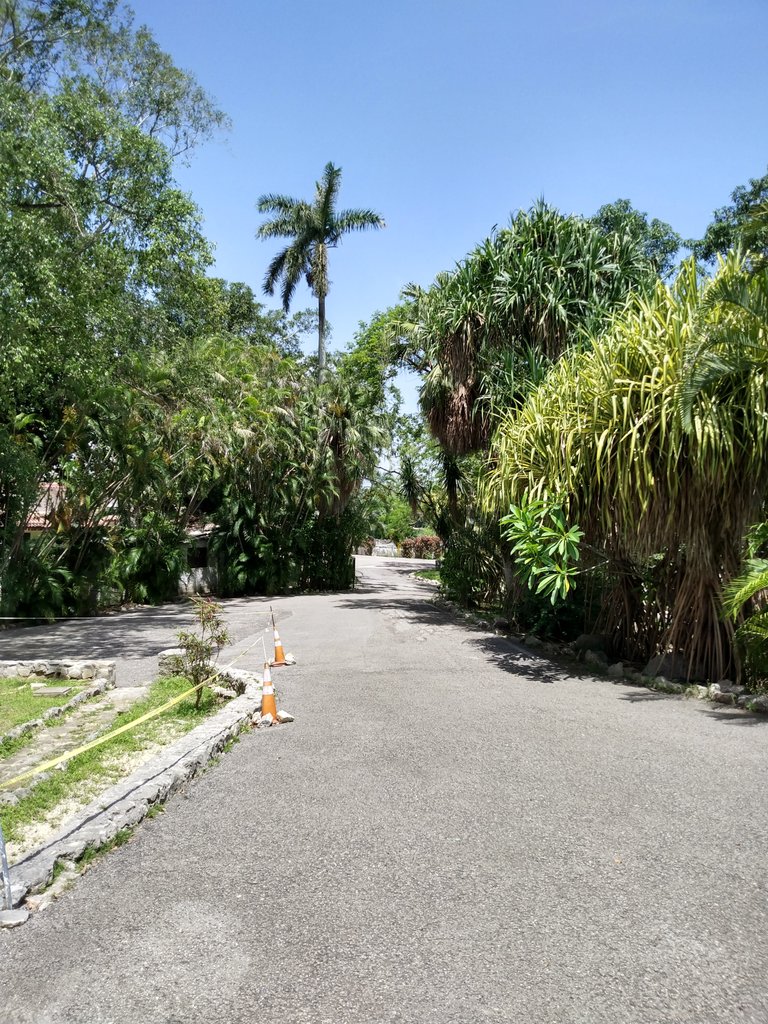
Place where we buy the entrance ticket.

Then, we went to the main house, today converted into the Ernest Hemingway House-Museum, where the writer's belongings are perfectly preserved, as if they were waiting for his return. Hemingway spent almost half of his useful years as a writer in this building and it was here that he wrote his main literary works such as: Paris was a party, Islands in the Gulf, Across the River, Among the Trees, and The Old Man and the Sea. Here, I share with you images of the exterior and interior of the property.



Main Hall
The Main Hall was where important visitors were received, among them famous personalities from politics, literature and cinema. On the walls you can see paintings of bullfighting scenes, painted by the Spanish artist Roberto Domingo.

Among the main pieces in the room is Ernest's favourite armchair, which is a comfortable low sofa located next to a small bar with a collection of 900 records and an old record player that still works.

There are also side tables, bookcases and hunting trophies. Here we can see gazelle and antelope heads, separated by a bullfight painting, common elements on almost all the walls of the house.
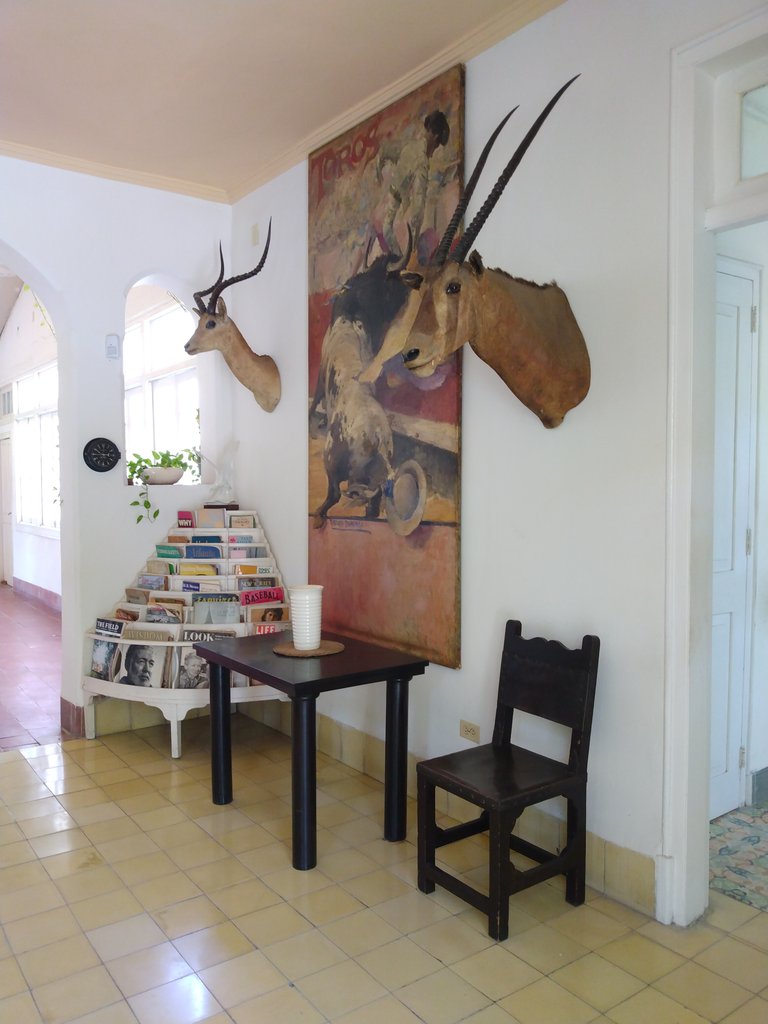


The library
It contains more than 9000 copies of magazines, books and other publications. It is curious to see that the writer did not organise them by genres and authors as is commonly done, but rather they are arranged irregularly. Among the main literary works are classics of world literature such as: the complete works of Mark Twain, Benito Pérez and Honorato de Balzac, among others. Initially it was a guest room, but due to the number of books, his wife Mary Welsh redesigned the interior to function as a library.



The Desk
As such, Hemingway did not use this compartment for its true function, but rather it was used to accumulate objects, transforming it into a kind of museum where he collected items acquired during his travels around the world. Here the head of a huge caffre buffalo, which Ernest himself hunted during his first safari in Tanzania, stands out.



Double bedroom
In this room he and his wife slept, most of the books and other objects here belonged to his wife. This was considered the main domain of the house.

Workroom
In this room of the house, Hemingway usually wrote in the early hours of the day. During that time there must have been total silence on the estate. He used to work on his typewriter or with a pencil, barefoot, standing and in shorts without a shirt. Here, works were written such as: The Garden of Eden, The Old Man and the Sea, Islands in the Stream and Paris was a party, etc.

Bathroom
It is located in the west wing of the house. It is interesting how Hemingway still had a bookcase and a magazine rack here where he collected publications on subjects of interest to him. In addition, a weighing scale is preserved where he used to weigh himself daily and then write down these measurements on one of the walls.


The tower
At the side of the house is a three-storey building some 12 metres above the ground. It was the brainchild of Mary Welsh and the top floor was intended as a place for the writer to work, but he never actually wrote here. Rather, he used it to review galley proofs of his books and other matters unrelated to the creation of publications. Unfortunately, I was not able to climb the tower, as it was under restoration.


The Bungalow
The Bungalow is a wooden building mainly for the use of his children when they visited the estate. This is where the Italian Countess Adriana Ivancich, whom Hemingway brought to literature through the character of Renata in his novel ''Across the River and Through the Trees'', stayed.


Further into the estate we come across the swimming pool where Hemingway liked to swim for half a mile when he finished his work.


At the side of the pool are four small graves with the names of his four dogs.

And right next to it we find what used to be the old tennis court that now houses his beloved yacht ''Pilar'', in which he used to do his fishing. It was built in American black oak and had petrol engines that reached a speed of 8 knots.
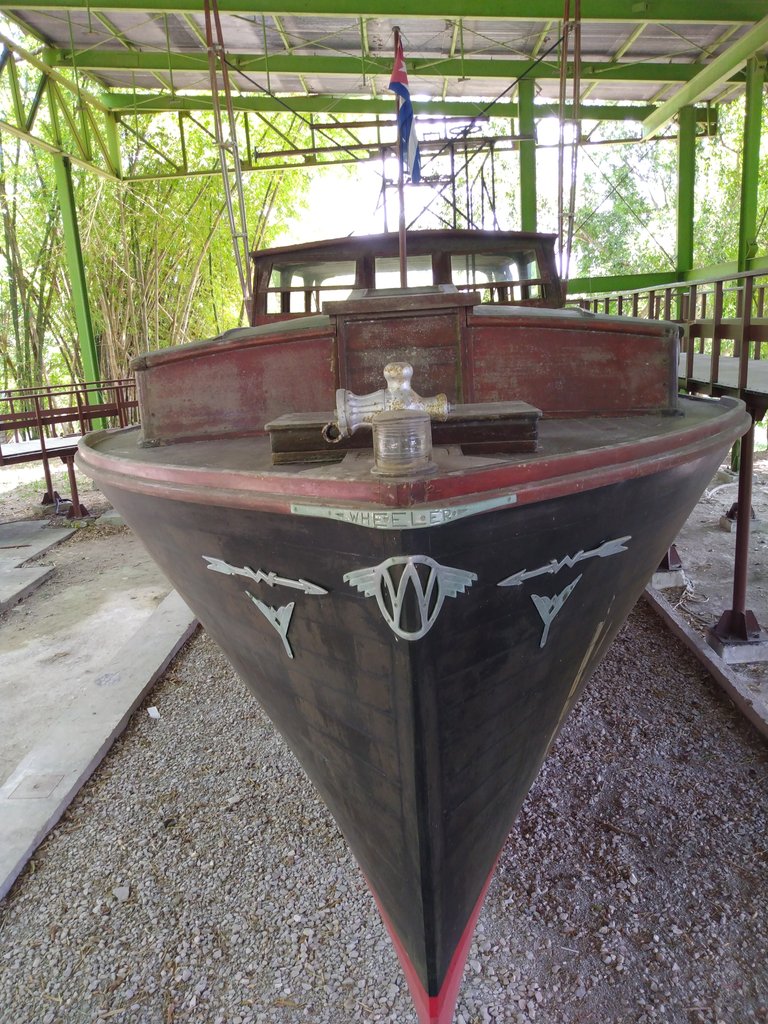
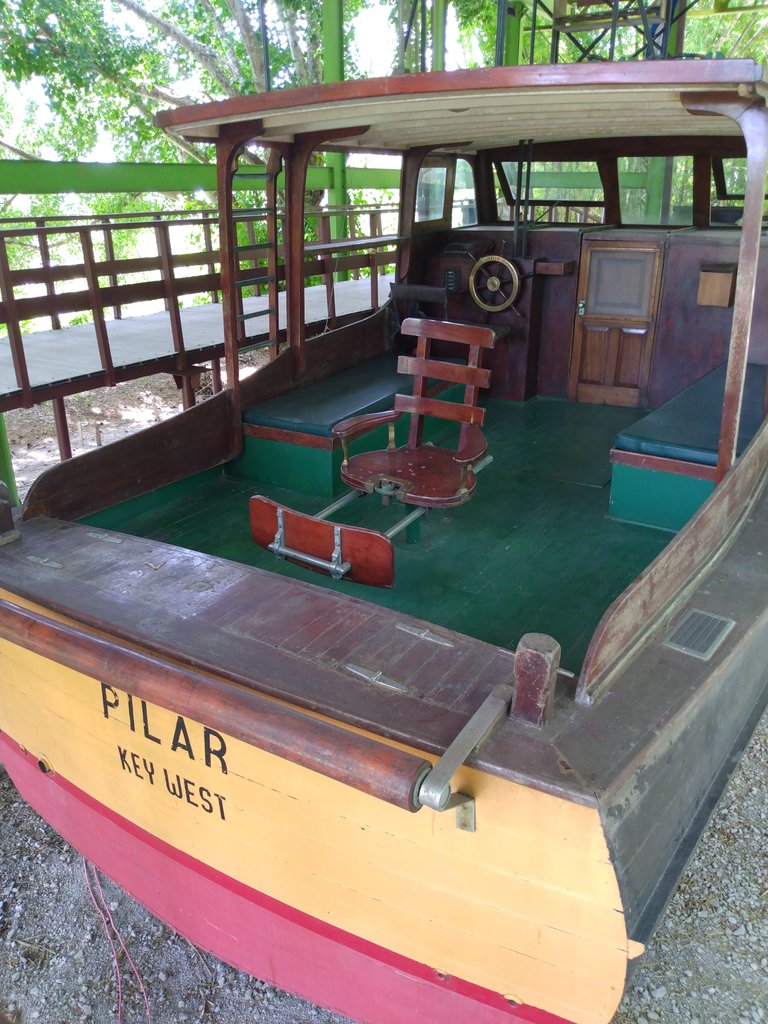

Monument in honour of Ernest Hemingway, built by Johan Falkman and inaugurated on the 500th anniversary of the city.

And with images of the house of souvenirs and magazines related to the life and work of Ernest Hemingway we conclude our tour of the Finca Vigía. I invite you to visit this corner of Havana full of history and natural beauty. See you on the next excursion. Best regards.
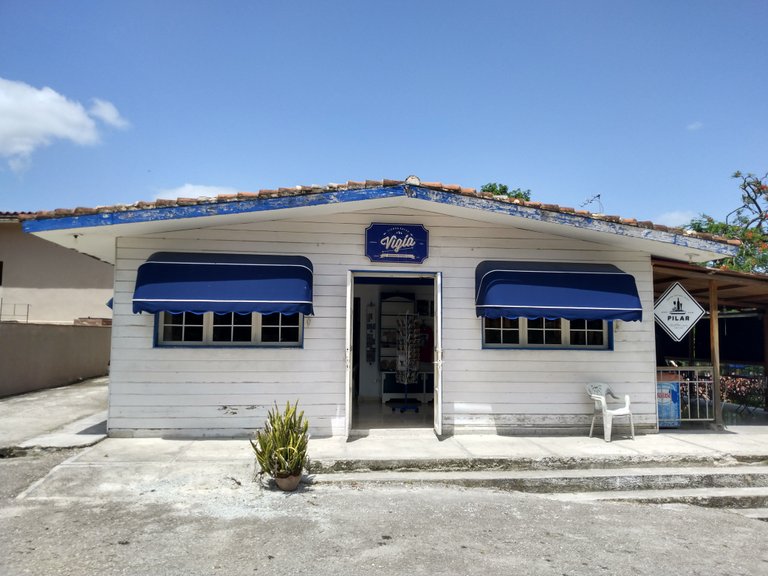
All photos are mine, taken with my Moto g play (2021) mobile phone.
Translated at DeepL.
Versión en Español
Hola querida comunidad de viajeros!! En esta ocasión les presento mi experiencia por uno de los rincones emblemáticos de La Habana. Se trata de la Finca Vigía, quien fuera por unos 20 años el hogar del afamado escritor norteamericano Ernest Hemingway. Se encuentra ubicada a unos 15 km al SE del centro de la capital, en la barriada de San Francisco de Paula perteneciente al municipio San Miguel del Padrón. Cuba fue como la segunda patria para el escritor desde 1928, año en que hizo su primer viaje a la isla y quedó enamorado para siempre.
La idea de vivir en este sitio surgió de su tercera esposa Martha Gellhorn, la cual cansada de la vida itinerante en habitaciones de hotel decidió responder a un anuncio clasificado acerca de la venta de: ´´Propiedad en ruinas en San Francisco de Paula´´, mudándose hacia ella en 1940, pero fue su cuarta esposa, Mary Welsh, la encargada de condicionar la finca Hasta que en 1960 Mary y Ernest abandonaron la isla tras el triunfo de la Revolución Cubana. Finca Vigía, fue construida en 1886 por el arquitecto español Miguel Pascual Baguer con el objetivo de puesto de vigilancia del ejército español, de ahí su nombre, ya que se ubica en una colina de unos 100 m sobre el nivel del mar, desde donde se puede tener una vista panorámica de la ciudad. Posee casi cuatro hectáreas de extensión con una exuberante vegetación tropical, convirtiéndolo en una pequeña reserva ecológica. Después de una breve historia, iniciamos nuestro recorrido. Espero les guste.
En la entrada nos encontramos con una garita donde unos custodios nos permiten el acceso y nos dan la bienvenida a la propiedad. Después, caminaremos unos 100 m por un camino asfaltado custodiado por abundante vegetación que nos conduce directamente a un inmueble donde comparemos nuestro ticket de entrada con un valor de 15 CUP (0.04 USD).
Camino que nos conduce a los inmuebles de la Finca Vigía.
Local donde realizamos la compra del ticket de entrada.
Luego, nos dirigimos a la casa principal, hoy convertida en la Casa-Museo de Ernest Hemingway, dónde se conservan perfectamente las pertenecias del escritor, cual si estuvieran esperando por su regreso. En este inmueble, Hemingway pasó casi la mitad de sus años útiles como escritor y fue aquí donde escribió sus principales obras literarias como: París era una fiesta, Islas en el Golfo, A través del río, Entre los árboles; y El viejo y el mar. He aquí, les comparto imágenes del exterior e interior del inmueble.
Sala Principal
La Sala Principal, era donde se recibían a los visitantes importantes, entre ellos célebres personalidades de la política, la literatura y el cine. En las paredes se pueden apreciar cuadros con escenas de corridas de toros, pintados por el artista plástico español Roberto Domingo.
Entre las principales piezas del recinto se encuentra la poltrona favorita de Ernest, la cual es un cómodo sofá bajo ubicado junto a un pequeño bar con una colección de 900 discos y un antiguo tocadiscos que aun funciona.
También están presentes mesas auxiliares, libreros y trofeos de cacería. He aquí observamos unas cabezas de gacela y antílope, separadas por un cuadro de corrida de toros, elementos estos comunes en casi todas las paredes de la casa.
La biblioteca
En ella se conservan más de 9000 ejemplares entre revistas, libros y otras publicaciones. Es curioso ver que el escritor no las organizó por géneros y autores como comúnmente se realiza, sino más bien están dispuestas irregularmente. Entre las principales obras literarias se encuentran clásicos de la literatura universal como: las obras completas de Mark Twain, Benito Pérez y Honorato de Balzac, entre otros. Inicialmente era una habitación de huéspedes, pero debido al número de libros, su esposa Mary Welsh rediseño su interior para que funcionara como biblioteca.
Escritorio
Como tal, Hemingway no utilizaba este compartimiento para su verdadera función, sino más bien se utilizó para acumular objetos, transformándolo en una especie de museo donde coleccionaba piezas adquiridas durante sus viajes por el mundo. Aquí llama la atención la cabeza de un enorme búfalo caffre, que el mismo Ernest cazó durante su primer safari en Tanzania.
Habitación matrimonial
En esta habitación dormían él y su esposa, la mayoría de los libros y otros objetos presentes aquí pertenecían a su esposa. Esta era considerada el principal dominio de la casa.
Cuarto de trabajo
En este local de la casa comúnmente, Hemingway acostumbraba a escribir en las primeras horas del día. Durante ese tiempo debía haber un total silencio en la finca. Él acostumbraba trabajar en su máquina de escribir o con un lápiz, descalzo, de pie y en bermudas sin camisa. Aquí, fueron escritas obras como: El Jardín del Edén, El Viejo y el Mar, Islas en la corriente y París era una fiesta, etc.
Baño
Se encuentra ubicado en el ala oeste de la casa. Es interesante como Hemingway aun aquí tenía un librero y un revistero donde coleccionaba publicaciones con temas de su interés. Además, se conserva una pesa donde el acostumbraba a pesarse diariamente y luego estas mediciones las anotaba en una de las paredes.
La Torre
A un costado de la casa se encuentra una edificación de 3 pisos y unos 12 m de altura sobre el suelo. Fue ideada por Mary Welsh y el último piso lo había ideado como un sitio de trabajo para el escritor, pero él nunca llegó a escribir aquí. Más bien, lo usó para revisar las pruebas de galeras de sus libros y otros asuntos que no estaban relacionados con la creación de publicaciones. Lamentablemente, no pude subir a la torre, pues se encontraba en restauración.
El Bungalow
El Bungalow es una edificación de madera destinada principalmente a sus hijos cuando visitaban la finca. Aquí se hospedó la condesa italiana Adriana Ivancich, quien Hemingway llevara a la literatura por medio del personaje de Renata en su novela ´´Al otro lado del río y entre los árboles´´.
Adentrándonos en la finca nos encontramos con la piscina donde Hemingway gustaba de nadar media milla cuando concluía su trabajo.
A un costado de la piscina se encuentran cuatro pequeñas tumbas con los nombres de sus 4 perros.
Y justo al lado nos encontramos con lo que era la antigua cancha de tenis que actualmente alberga a su querido yate ´´Pilar´´ en el cual realizaba sus pescas. Fue construido en roble negro americano y poseía motores de gasolina que alcanzaban una velocidad de 8 nudos.
Monumento en honor a Ernest Hemingway, construido por Johan Falkman e inaugurada en los 500 años de la ciudad.
Y con imágenes de la casa de suvenires y revistas relacionados con la vida y obra de Ernest Hemingway concluimos nuestro recorrido por la Finca Vigía. Les invito visitar este rincón de La Habana cargado de historia y belleza natural. Nos vemos en la próxima excursión. Un saludo cordial.
Todas las fotos son mías, tomadas con mi teléfono móvil Moto g play (2021).
Traducido en DeepL.
¡Felicitaciones!
1. Invierte en el PROYECTO ENTROPÍA y recibe ganancias semanalmente. Entra aquí para más información.
3. Suscríbete a nuestra COMUNIDADEntra aquí para más información sobre nuestro trail., apoya al trail de @Entropia y así podrás ganar recompensas de curación de forma automática.
4. Creación de cuentas nuevas de Hive aquí.
5. Visita nuestro canal de Youtube.
Atentamente
El equipo de curación del PROYECTO ENTROPÍA
Gracias por su voto
Congratulations, your post has been added to WorldMapPin! 🎉
Did you know you have your own profile map?
And every post has their own map too!
Want to have your post on the map too?
Thanks
Muy bonita e interesante tu publicación. Me recordó mi época en el preuniversitario, tuve oportunidad de visitar este museo varias veces. Muchas gracias por compartir. Un abrazo
Muchas gracias Merci. Que bueno que te haya hecho recordar buenos momentos. Bss
Congratulations you received an ecency upvote through the curator @ahmedhayat. Keep spreading love through ecency
Muchas gracias